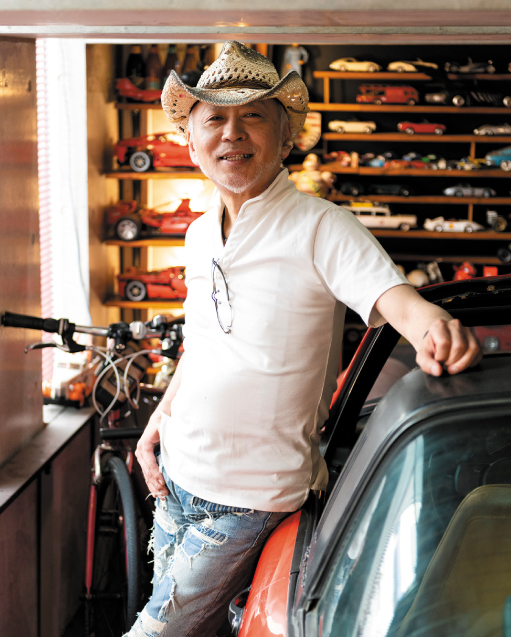
Takashi Ohta creates figurative works of art that realistically depict cityscapes and human conduct by combining layers of paper cutouts based on meticulously calculated compositions. These semi-3-dimensional tableaus made of paper of different textures and colors reproduce not simply the intricate beauty of a cut-out landscape, but also the small dramas of everyday life, woven together by people with diverse and unique expressions. Through the words of the artist, Takashi Ohta,we will explore the hidden charm of these works that stir emotions deep in the hearts of the viewers.


Paper Artist
Takashi Ohta
Born in 1964 in Kiyose City, Tokyo. Graduated from Nihon University College of Art, Department of FineArts. Launched the PAPER MUSEUM series in the automotive magazine CAR GRAPHIC in 1995.
In 2002, Ohta won the paper crafts championship on the TV Tokyo game show TV Champion. He is the recipient of various awards. He has exhibited his works at the Kaminote - Nippon Exhibition and held numerous solo exhibitions at art galleries and museums throughout Japan. Ohta is active in a variety of fields, such as creating opening title backgrounds for TV series and proposals for product promotions.


Kiyose Station was opened on June 11, 1924 as a station of the Musashino Railway, the predecessor of the Seibu Ikebukuro Line. Ohta, who was born in the area, created this work of art depicting Kiyose Station as part of a commemorative project celebrating the station’s 100th anniversary. In the composition, which shows the station building as seen from the railroad crossing on the west side of the station, where the tracks and the street meet, Kiyose residents, dogs, vehicles, and train cars coexist in a way that blends past and present and transcends time and space.

By cutting out familiar scenes from our daily lives and inserting people talking with one another, dogs with adorable expressions, and cars realistically rendered down to the shine, the artist weaves rich and profound narratives. As a pioneer of paper art, Takashi Ohta creates works that are full of surprises and joy beyond the realm of realistic depictions, and are humorous with a human touch.
Ohta began creating paper art a few years after graduating from theNihon University College of Art. Having always excelled in the precise depiction of images, he embarked on a search for original means of expression, which led him to a new technique of layering sheets of paper cut along line drawings to express depth. “Ever since I was a child, I loved to draw pictures, but realistic reproduction alone was not enough for me to survive as an artist,” he says. “With this in mind, I came up with the technique of creating light and shadow by layering and curving paper.”

Ohta’s major turning point came in 1995. He was commissioned to create a series of works for the automotive magazine CAR GRAPHIC, which led to a busy schedule of creating new works every month. “The readers of the magazine were passionate about cars, and many of them were particular about details and expressions, so I sometimes received elaborate comments from them, but I accepted these comments as loving words of encouragement (laughs). This series, which ran for 26 years, gave me the opportunity to present my work to a wide audience,” Ohta says. His subsequent works, published monthly in the magazine, attracted a great deal of attention, and the following year Ohta held his first solo exhibition. Since then, his work has been widely featured in various media, and he has been inundated with commissions from companies, municipalities, and art museums nationwide.
The essence of Ohta’s work is that he uses dozens of different types of paper with distinctive textures to realistically recreate each scene. He creates his own unique world view by selecting the most appropriate paper based on the detail and pattern of the embossing and the texture and hues of the paper, and by combining papers of different textures to convey the appearance of wood, brick, steel, and stone for buildings, and jackets, knitwear, and jeans for people. “I have experimented with all kinds of paper,” Ohta says. “Compared to the traditional art of paper-cutting kiri-e, my work has a different kind of precision, visually conveying warmth and nuance that only paper can express.” Ohta’s artworks, which resonate with the hearts of viewers, are based on his many years of in-depth exploration of different paper types in search of the essence of paper.

The dynamic and happy expression of the Shiba dog as it suddenly takes off running is beautifully rendered. The wrinkles in its owner’s clothing and the gesture of holding down her hat are all details that add a sense of reality to the scene.

Historic models of Seibu Railway train cars wait at the platform. The gravel used to pave the tracks is made of cork.

Right: The three-wheeled cars that were in active use after the war are rendered in monochrome to distinguish them from the modern bicycles that residents ride.
Left: The facial parts of the human figures are arranged into subtle expressions by pulling out or pushing in the incisions.


①Use a pattern cutter to cut the pieces from the pattern paper.

②Use an awl to give the pieces a rounded shape.

③Place the cut pieces in temporary positions and check the balance of color combinations, etc.

④The paper stock used is organized by texture.

Last year, Ohta raised funds through crowdfunding and held a galleryexhibition on the streets of New York City to spread the appeal of Japan’s distinctive and beloved paper art to the world. “In the future, I intend to promote my works under the theme of ‘conveying information,’ for example, by uploading videos to social medias. I hope that my work will serve as an opportunity for people to learn about the charm and history of the places they represent. Beginning with places near and dear to me, such as Kiyose, where I was born and raised, Ekoda, where I graduated from university, and Ikebukuro as the starting point, I would like to contribute to conveying the local charm by creating artworks for each station along the line,” says Ohta. Stay tuned for more from this artist who, even now that he has achieved recognition, continues to challenge the status quo.








